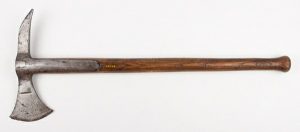I know I’ll get some comments about a title of “Viking Axe and Indian Tomahawk”. Why am I not calling them Native Americans? Maybe the Vikings should be called Native Scandinavians? Come on, people!! There is no such thing as a “safe place” on this web site. But I will promise to be respectful to everyone and teach a little history today.
Viking Axe
If you watch the Vikings tv show on the History Channel, you see a lot of battles where the Viking warriors use axes in battle while wearing little to no armor. They fight against Englishmen wearing heavy armor, who depend on shield and sword. The Vikings had genetics in their favor, and were visibly taller and broader. Most Viking warriors were also farmers who built up their strength by working hard to grow food and raise animals in the harsh Scandinavian countryside. They were tough, determined people. Every year they came together and raided foreign lands for wealth, slaves and other goods for trade. Combat was a way of life. Taught to boys at a young age by their fathers, including the girls if they showed interest.
 The axe was an everyday tool. Used for building, firewood, and most importantly ship building. The typical axe carried into battle was a version of the bearded axe (pictured to the right from Gransfors Bruk). Pointed at the top and blunt at the bottom. The blunt part was useful for hooking shields or legs in battle. A common tactic was to hook an enemy’s legs and drop them to the ground. While they were trying to get up, it was easy to deliver a killing blow. Most of the enemies that Vikings encountered in battle were not used to fighting against axes.
The axe was an everyday tool. Used for building, firewood, and most importantly ship building. The typical axe carried into battle was a version of the bearded axe (pictured to the right from Gransfors Bruk). Pointed at the top and blunt at the bottom. The blunt part was useful for hooking shields or legs in battle. A common tactic was to hook an enemy’s legs and drop them to the ground. While they were trying to get up, it was easy to deliver a killing blow. Most of the enemies that Vikings encountered in battle were not used to fighting against axes.
There are several organizations that teach Viking fighting styles:
Indian Tomahawk
One major difference between the Viking axe and the Indian tomahawk stems from the fact that there were no blacksmiths in North America before European contact. So the tomahawks that were used by the Indians were made of stone, wood, and bone. Metal tomahawks didn’t appear until boarding axes used by sailors were offered in trade to Native Amerians.
A boarding party would always include a complement of axe carriers to support the main body of marines and sailors armed with musket and cutlass. As the axes were generally stored in racks near each gun they were also handy for defence against enemy boarders, being quickly available to the gun crews to cut grappling lines or defend themselves. From: BoardingAxe.com
 The image to the right is a standard boarding axe design. Which is very much like the typical tomahawk axe head. The Indians modified them to fit their fighting styles, often wrapping the handles with leather and decorating them with carved designs, but the axe heads changed very little. The indian tomahawk had a small blade (called a bit) on the front, usually measuring four inches or less. The back of the head (poll) was shaped into a spike. Some ceremonial tomahawk polls were shaped into a pipe.
The image to the right is a standard boarding axe design. Which is very much like the typical tomahawk axe head. The Indians modified them to fit their fighting styles, often wrapping the handles with leather and decorating them with carved designs, but the axe heads changed very little. The indian tomahawk had a small blade (called a bit) on the front, usually measuring four inches or less. The back of the head (poll) was shaped into a spike. Some ceremonial tomahawk polls were shaped into a pipe.
Like the Vikings, the Indians were strong, hard working people. They spent a lot of time hunting and battling between tribes.
There are a few organizations that teach Indian fighting styles:
Viking Axe vs. Indian Tomahawk Conclusion
A lot of preppers have an axe of some sort attached to their bug out bags. I think a nice felling axe is a good addition for its practical uses. But if you plan to fight with an axe, the tomahawk is the go-to right now. There are some really nice ones available on Amazon. With some serious training, an individual could be proficient and quite lethal.
But I don’t think enough people look at the Viking axe seriously. Though it is a little larger and heavier, it has a long brutal history. Plus with a larger bit it is easier to use for chopping wood, which is a chore that never seems to be finished.






[…] Prepper highlights the bearded axe in a recent post. (adsbygoogle = window.adsbygoogle || []).push({}); Learn More At Gransfors […]
i bought the cold steel riflemans hawk around 15 years ago this thing ROCKS
Indians were stone age people and Vikings iron age.
White man invented the tomahawk.
White man showed Indians how to ride a horse.
Any amount of research greater than the obvious zero seconds you put into this statement would prove you to be wrong. Tomahawk is a loanword that white men took from Indian groups in the North East, the Iroquois and the Algonquian, with the original word looking something like “Tamahak” (Romanized). You made a very large sweeping statement, a logical fallacy mind you, saying that the group you call Indians were stone age people. I am guessing from your lack of knowledge on this subject and your previous sweeping statement that you have generalized the term “Indian” to refer to anyone who lives in the Americas pre-European contact. Indian is the appropriate word to use in this situation, but the groups to which it refers are large and extremely diverse. Tribes in North America, the North Eastern modern day U.S.A. were already making use of copper by the time Europeans arrived. Indian peoples living in modern day Peru, located in South America, were already into the bronze age, and had developed their own kind of tomahawks albeit they had a much different name. A quick review of what I’ve just said, your first statement is illogical and incorrect because the extremely broad group you refer to as “Indian” were not stone aged people. Your second statement is wrong yet again, Europeans did not invent the tomahawk, they didn’t even come up with the word tomahawk both the design and the name were taken from American peoples. The concept of a tomahawk is unique to Indians, although post-European contact Europeans and Indians alike developed the “pipe tomahawk.”
Let me just touch on your last point, white men weren’t showing Indians how to ride horses, they brought them over to the Americas, but they did not teach them to ride. Hernan Cortez was the first documented person to bring horses to the continental Americas, and the eight he brought with him were returned to Spain without teaching any of the Aztec among whom he interacted were ever given any equestrian lessons. The only thing white men gave to the Indians willingly was smallpox and the Gospel of Jesus. Simply because Europeans brought horses to the Americas doesn’t mean they were teaching the natives to ride.
Just because White men wrote Western history doesn’t mean all of what they wrote is true.
This is just a bonus round now, but you know horses were originally domesticated in central Asia, so to put this in terms you’ll understand – Asian man tamed horse – Asian man showed white man how to ride a horse.
If you bothered at all to invest time into learning about cultures besides your own you would learn about a lot of things that white men have that came from other cultures, this previous example of the horse is one of many things that White people have because of Asians, which are another group of peoples that are very culturally diverse, but labelled under one term.
If you’ve made it this far, nice, and if you are doubting what I am saying than I implore you to do your own research and come to your own conclusion, but if Tomahawks were truly invented by white men, which they weren’t why would they be called a tomahawk, and not a hatchet or an axe?
It seems a bit prejudiced that you choose to leave up a comment such as the one I am responding to, yet one discussing the true history is silenced.
[…] are pretty common, and few think of them as primitive weapons, but that is exactly what they are. The fighting axe and tomahawk are closely related, and often share similar skill sets. The well equipped prepper should have at […]
This OPINION is completely false. Phoenicians discovered America and Native Americans did in fact know how to smelt metal. Native Americans DNA compares of that of western Europeans and not Asians as previously thought. Native Americans worshiped a single God and their ancestors claimed they came from the sea on boats. Ancient ingots take the Phoenician shape of the Ox hide.
Ancient Israelite ‘Decalogue Tablet’ With Hebrew Inscriptions Found in Ohio River Valley in 1860
https://christiansfortruth.com/ancient-israelite-decalogue-tablet-with-hebrew-inscriptions-found-in-ohio-river-valley-in-1860/